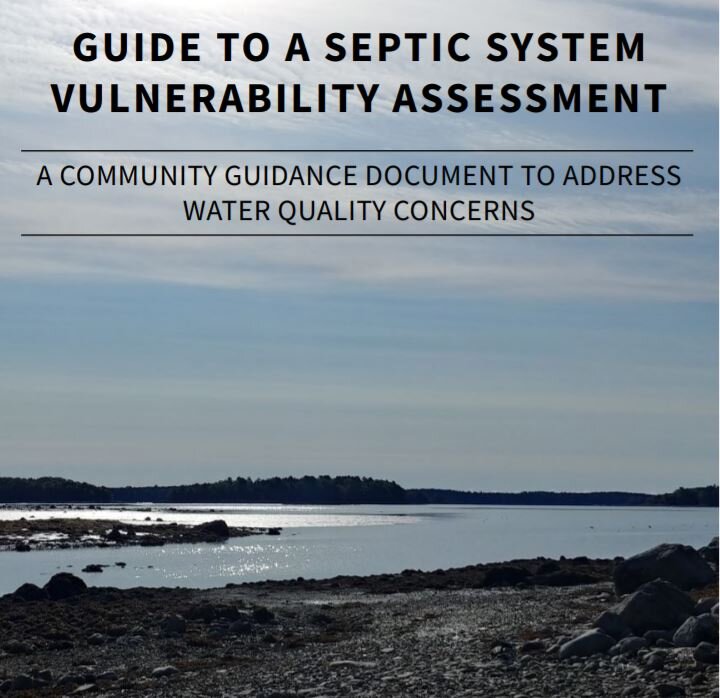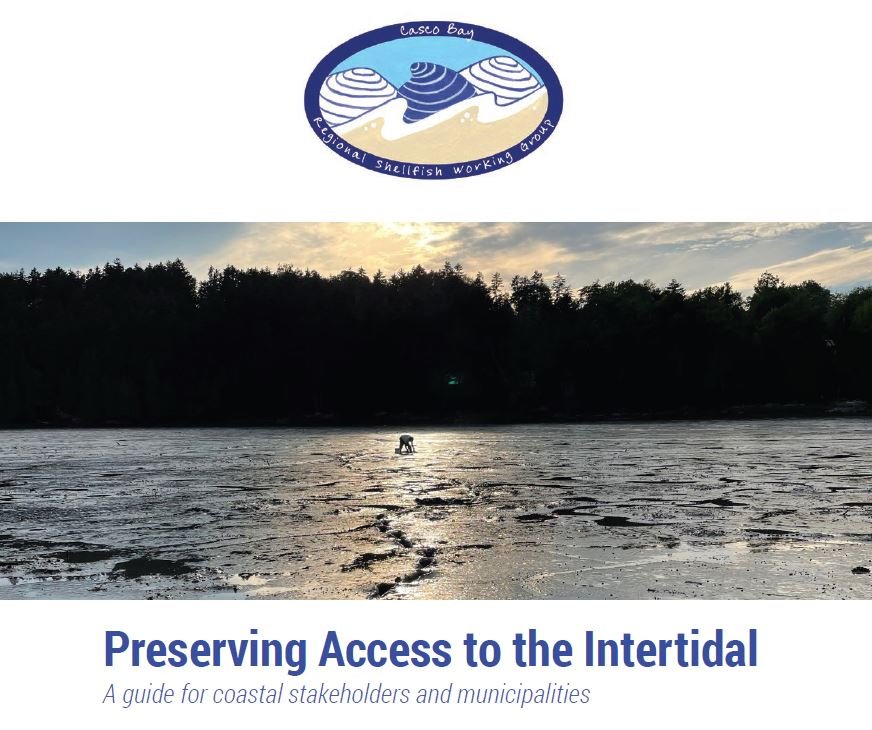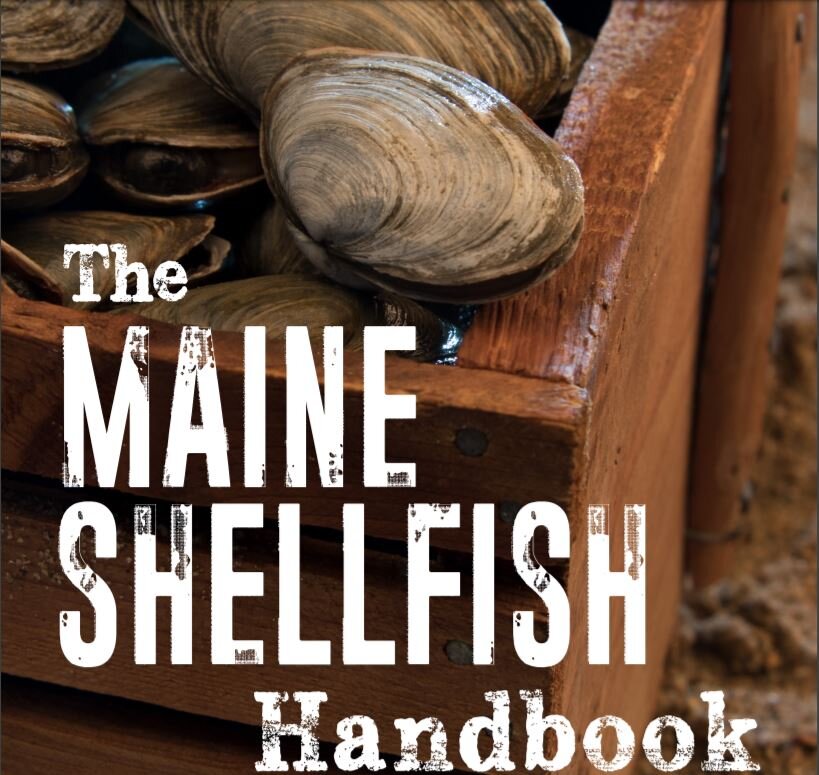
Informational Materials
The Casco Bay Shellfish Working Group periodically releases guidance documents, literature reviews, and other informational resources relevant to shellfish co-management and conservation. These resources are often developed in collaboration with partner organizations, member communities, and local universities. There are also relevant resources, technical guidance, and presentations provided here that were developed by local university students, researchers, and non-profits. Click on a topic below to jump to the relevant resources. Check back for new resources as they are published!
Water Quality
Guide to a Septic System Vulnerability Assessment: A Community Guidance Document to Address Water Quality Concerns
Malfunctioning septic systems can impair local waters with nutrients, bacteria, and other pollutants, and can be difficult to locate and fix. FB Environmental created a guidance document to help towns and shellfish harvesters concerned with high levels of nutrients and bacteria in their waterways identify septic systems vulnerable to malfunction or failure. The Septic System Vulnerability Assessment can provide a data-based view of the risk of pollution from septic systems in a town or watershed. A completed assessment helps focus municipal pollution prevention efforts on areas which are most likely to provide results. It also helps in making well-informed policy decisions, educating homeowners, and ultimately improving water quality.
This project was prepared for the Town of Waldoboro by FB Environmental Associates and Midcoast Conservancy under award CZM NA20NOS4190064 to the Maine Coastal Program from the National Oceanic and Atmospheric Administration, U.S. Department of Commerce. The statements, findings, conclusions, and recommendations are those of the author(s) and do not necessarily reflect the views of the National Oceanic and Atmospheric Administration or the Department of Commerce.
Water Quality Decision Tree
The Water Quality Decision Tool was developed by the Maine Shellfish Learning Network as a resource for communities in Maine that want to open clam flats that have been closed due to water pollution. It provides an overview of water pollution concepts, information about relevant governmental agencies, and guidance on how to identify and address pollution sources. It is intended help communities understand the complexities of water quality management in Maine and the steps to take to mitigate water quality issues locally.
Microbial Source Tracking Technical Brief
Microbial source tracking is a type of water quality testing that identifies fecal coliform bacteria and can help identify its source. This technical brief provides background information and resources for municipalities to get started.
Published in 2020 by Dr. Steve Jones (UNH) and Gabrielle Hillyer (UMO), in collaboration from the Maine Shellfish Learning Network.
Conservation and Management
Preserving Access to the Intertidal: A guide for coastal stakeholders and municipalities
In 2022, the Casco Bay Regional Shellfish Working Group created this guidance document in response to requests from members at our fall 2021 meeting. It is intended for municipal staff, shellfish/marine resource committees, coastal landowners, shellfish harvesters, and community members who want to protect and expand access to the intertidal in their communities. Anecdotally, shore access points are decreasing due to changes in land ownership as well as increasing pressure from climate change impacts, and many towns may be facing limits to capacity and/or resources. This guide is meant to be used on a local level, and provides tools that can be tailored to the specific goals and needs of each community. Each section tackles a different topic related to access, including: community outreach and engagement, the loss of access on private and public land, loss of access due to encroaching development, and infrastructure needs specific to commercial fishing/harvesting. There are also relevant contacts and a table of funding sources in the appendices.
Shellfish Conservation Activity Summary
In 2021, the Working Group developed a summary of shellfish conservation activities, including sections on stock enhancement, predator mitigation, pollution source identification, data collection, and community outreach. This document was designed to be a tool for municipal shellfish committees to use when deciding which conservation activities will have the most beneficial impact on their shellfish management goals, while keeping the constraints of their program in mind. It combines this with knowledge gathered from interviews with shellfish wardens and area biologists, and input from harvesters.
Maine Shellfish Handbook
Maine Sea Grant recently released the Maine Shellfish Handbook, which updates the Maine Clam Handbook (published in 1998). The material included in this edition has been selected with the purpose of assisting individuals and coastal towns in the development of shellfish management programs that encourage stewardship of local resources and promote sustainable coastal communities. This publication contains information on the history and biology of the soft-shell clam, northern quahog, American and European oysters, and blue mussels. Expanded sections on state resources to address water quality issues and predatory species have been added, as well as information about tools that municipalities can use to preserve or increase their intertidal shellfish resources.
Limited Purpose Aquaculture (LPA) License Workbook
The Maine Shellfish Learning Network (MLSN) and Manomet worked collaboratively with members of the shellfish community and the Maine Department of Marine Resources to create a a guide to help municipal shellfish committees apply for Limited Purpose Aquaculture (LPA) licenses. These licenses are required for various conservation projects, particularly focused on reseeding or revitalizing wild spawning for shellfish while using aquaculture technology or structures. This workbook walks the user step-by-step through the application process, including pictures and links to corresponding parts of the DMR website. A downloadable version is available at the link below, along with a step-by-step online guide and an accompanying video.
Quahog Management, Restoration, and Aquaculture: A review of case studies in Maine
Northern Quahog (Mercenaria mercenaria) landings in Maine have become the focus of several municipal shellfish committees in the Casco Bay region in the past decade, due to a general upward trend in quahog landings during this period. This document provides a summary of four case studies of quahog-focused conservation activities and research projects in Maine and one in Massachusetts. The takeaways from these case studies are intended to inform members of municipal shellfish committees, harvesters, and researchers.
Published in August 2020 by Josie Carter and Natalie Moon (Bates College) in collaboration with Jessica Gribbon Joyce (Tidal Bay Consulting)
Supporting Municipal Co-Management of Shellfish and Community Engagement in Casco Bay, Maine
In recent years, quahog landings have increased, leading to a need for municipal co-management to adapt to manage multiple species. This report summarizes research and case studies in MD, MA, RI, and WA to highlight methods being used to monitor, license, conserve, survey, and report multiple species at the local, tribal, and state level. This will inform decision-making for municipalities already managing multiple species of shellfish in ordinances or considering adding species.
Published in July 2020 by Sophia Miller, Josie Carter, and Natalie Moon (Bates College) in collaboration with Jessica Gribbon Joyce (Tidal Bay Consulting).
Summary of Casco Bay Municipal Shellfish Programs
This report highlights similarities and differences between the shellfish ordinances and programs of 11 of the communities invited to participate in the Casco Bay Regional Shellfish Working Group.
Published in November 2019 by Lily Nygren (Bates College) in collaboration with Jessica Gribbon Joyce (Tidal Bay Consulting).
Quahog Resource Survey Method
This report, prepared for the town of Brunswick, includes research on the Brunswick quahog population and best practices for managing quahog resources to avoid overfishing and underutilization.
Published in June 2015 by MER Assessment Corporation and Resource Access International.
Data and Monitoring
The Department of Marine Resource (DMR) landings data portal is a public, online database of annual value and volume of species harvested in Maine, as well as effort data such as number of harvesters and number of trips. There is an option to view graphs on the website by selecting filters such as port or species, or the data can be downloaded into a spreadsheet. The Casco Bay Regional Shellfish Working Group (WG) has been working with DMR staff to better understand how shellfish landings data are collected and reported before sharing data with WG members.
The WG team compiled soft-shell clam and quahog landings data into a summary document (click ‘Read the Report’ below to download a PDF). This document has graphs and tables for the following towns: Brunswick, Freeport, Georgetown, Harpswell, Phippsburg, Scarborough, West Bath, Woolwich, and Yarmouth, as well as combined landings data for the Casco Bay region (from 2018-2022). The tables are species-specific, and include volume, value, number of harvesters, and trips. Graphs are also separated by species and display volume (lines) and value (bars) by year. If a town only displays data for one species, it is because the data are confidential for the other species. There are some important caveats to note when viewing these graphs and tables, which are explained in the introduction.
Using a Stakeholder Engaged Approach to Understand and Address Bacterial Transport on Soft-Shell Clam Flats
Researchers from the University of Maine conducted a case study using bucket drifters and hydrodynamic modelling (based on finite volume community ocean model or FVCOM) to study the impact of cross-estuary winds during slack tides on bacterial transport across mudflats. This study also highlights the benefits of engaging stakeholders in the monitoring and data collection process when conducting research in small-scale fisheries.
Sediment Variation and Occurrence of the Milky Ribbon Worm in the Gulf of Maine
A student from Bates College, Isabel Mohammadi-Hall, researched the impact of sediment variation of intertidal flats on the presence of milky ribbon worms (Cerebratulus lacteus) at six study sites in the Gulf of Maine. The study found that areas with high concentrations of “clayey silts” had a higher occurrence of milky ribbon worms. The deposition of finer, silt-heavy sediments promotes the tunneling of microorganisms like the milky ribbon worm. There is anecdotal evidence that intertidal sediments are softening in areas of the Gulf of Maine, which may be attributed to historical human activity causing finer sediments to deposit in mudflats. A higher occurrence of milky ribbon worms is associated with a higher mortality of soft-shell clams.
Green Crab Population Trends 2018-2021
This presentation by Dr. Marissa McMahan, the Director of Fisheries at Manomet, explains Manomet’s long-term green crab monitoring program, which spans Maine’s mid-coast region and presents the green crab population trends observed at each monitoring station. The applications of this data for fisheries management include informing mitigation, fishery development, and predicting long-term trends in green crab populations.
The Natural History of the Milky Ribbon Worm: As Told by Maine Clam Diggers
Oaklea Elfström, a student from Bates College, recently published her thesis on the natural history of the milky ribbon worm (Cerebratulus lacteus) based on interviews with shellfish harvesters in Maine. She conducted interviews with shellfish harvesters on their experiences with the milky ribbon worm and used this local ecological knowledge to develop recommendations for further research on milky ribbon worm habitat, mitigation, predation mechanisms, and more.
Milky Ribbon Worm Predation and Mitigation: A Review
Milky ribbon worms (Cerebratulus lacteus) (MRW), present a large threat to the survival of soft-shell clam populations throughout the intertidal along the coast of Maine. This document summarizes available research on the MRW, its life cycle, clam predation, control methods, and other considerations. It is intended to serve as a resource for municipalities to better understand MRW predation of soft-shell clam populations, as well potential predator control strategies.
Published in July 2020 by Josie Carter and Natalie Moon (Bates College) in collaboration with Jessica Gribbon Joyce (Tidal Bay Consulting).
2020 Clam Recruitment Monitoring Network Report
The 2020 Clam Recruitment Monitoring Network Report was published by the Downeast Institute, and uses data from Wells, Scarborough, Brunswick, Wiscasset, Bremen, Islesboro, Frenchman's Bay, Beals, and Sipayik. The report includes: clam and quahog recruitment densities at 18 different clams flats, recruit growth rates, recruit survival rates, green crab numbers and size, relationship between presence of green crabs larger than 10mm and mortality of clam recruits, and temperatures throughout the clam spawning and growing season. This information could help the shellfish community understand the impacts a dramatically warming marine ecosystem has on clam populations and to identify local, regional, and coastwide trends in clam production.
Deploying Bucket Drifters
Bucket drifters are used to understand how water moves in an estuary or other shallow coastal system. They can be used to map currents and inform shellfish committees when making decisions about seeding, pollution, and other concerns. This brief was created to help municipalities build, deploy, and analyze their own bucket drifters.
Published in 2019 by Gabrielle Hillyer (University of Maine) in collaboration from the Maine Shellfish Learning Network.
Marketing Resources
A Fisherman’s Guide to Selling Seafood in Maine
This guide to selling seafood details the licenses needed for selling different kinds of seafood in different situations in Maine. It includes a section near the end specific to clam and other bivalve sales.
Published in 2018 by the Gulf of Maine Research Institute.
Maine Shellfish Direct Sales
How do you bring your landings to market as a harvester? This handout highlights different avenues to sell your product, summarizes regulatory and licensing requirements, and provides resources for further information.
Published in 2020 by the University of Maine.
Community Outreach
Town Council Outreach and Education Materials
Municipal shellfish committees can use these resources to start a conversation with their town council or board of selectmen about the ecological, cultural, and economic importance of the wild-harvest shellfish fishery in their community. The presentation template is adaptable for any community in the Casco Bay region, and the accompanying handout can be distributed prior to the meeting.
Published in December 2020 by Josie Carter and Natalie Moon (Bates College), in collaboration with Working Group facilitators and members.
Banner Image from Christine Stack Photography.






















